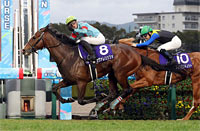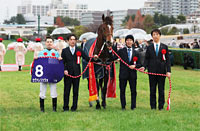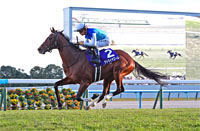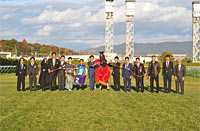Asahi Hai Futurity Stakes (G1) - Data Analysis
Gunning for the prestigious title of champion 2-year-old
The Asahi Hai Futurity Stakes, the race to decide the pick of a generation for 2-year-olds, is almost upon us. There was plenty of drama last year, when Leontes produced an explosive spurt down the home stretch to become the first horse in the history of this race with only one career run. Held on the 1,600m turf course at Nakayama until 2013, the venue changed to the 1,600m outer turf course at Hanshin in 2014. Now let’s analyze trends in this race over the last 10 years, including years when it was held at Nakayama.
Ample scope for upsets
When aggregating results over the last 10 years in terms of favoritism, we find that runners backed as “1st favorite” have posted the best Top 2 and Top 3 ratios. Those coming with “2nd favorite” tags have the same Win ratio as the “1st favorite” with three wins, and also boast the second best Top 2 and Top 3 ratios. In fact, the “1st favorite” has finished in the Top 2 (with one win and one runner-up spot) in each of the two years since 2014, when the venue changed to Hanshin Racecourse. The “2nd favorite” has also won once in that time, underlining the success of horses backed among the higher favorites. There have also been some upsets, however; for example, 14th favorite Arma Waioli finished 2nd in 2014, while 11th favorite Shadow Approach came home 3rd in 2015. It could be worth remembering this sequence of successes by less favored runners. [Table 1]
[Table 1] Performance by favoritism (last 10 years)
| Favoritism |
Performance
[1st-2nd-3rd-4thor lower] |
Win ratio |
Top 2 ratio |
Top 3 ratio |
| 1st favorite |
3-2-2-3 |
30.0% |
50.0% |
70.0% |
| 2nd favorite |
3-1-1-5 |
30.0% |
40.0% |
50.0% |
| 3rd favorite |
1-0-2-7 |
10.0% |
10.0% |
30.0% |
| 4th favorite |
1-2-1-6 |
10.0% |
30.0% |
40.0% |
| 5th favorite |
1-1-2-6 |
10.0% |
20.0% |
40.0% |
| 6th-9th favorite |
1-2-1-36 |
2.5% |
7.5% |
10.0% |
| 10th favorite or lower |
0-2-1-68 |
0% |
2.8% |
4.2% |
Strong showing by Top 2 finishers in their debut race
Viewing aggregate performances by runners over the last 10 years in terms of their finish in their debut race, eight of the 10 winners had also finished “1st” in their first career start. The other two had finished “2nd” on their debut. On the other hand, the 47 horses finishing “3rd or lower” in their debut race over the last 10 years have not only failed to produce a single winner, but only two of them have finished 2nd. Even over the last two years since this race has been held at Hanshin, all four of the Top 2 finishers had also finished “In the Top 2” on their debut. We should be sure to check the runners’ finish in their debut race. [Table 2]
[Table 2] Performance by finish in debut race (last 10 years)
| Finish in debut race |
Performance
[1st-2nd-3rd-4th or lower] |
Win ratio |
Top 2 ratio |
Top 3 ratio |
| 1st |
8-8-5-76 |
8.2% |
16.5% |
21.6% |
| 2nd |
2-0-1-14 |
11.8% |
11.8% |
17.6% |
| 3rd |
0-1-2-11 |
0% |
7.1% |
21.4% |
| 4th |
0-0-1-6 |
0% |
0% |
14.3% |
| 5th |
0-1-0-11 |
0% |
8.3% |
8.3% |
| 6th or lower |
0-0-1-13 |
0% |
0% |
7.1% |
Check race positioning during the first JRA win
On investigating the performance of runners over the last 10 years by their position at the 4th corner during their first win in a JRA race, all 10 winners in that time had passed the 4th corner in “2nd-6th position” in that race. What’s more, all four Top 2 finishers in the last two years since the move to Hanshin had passed the 4th corner in that race “within the top 4 positions.” In other words, horses seem to perform well in this race if they passed the 4th corner in a relatively forward position during their first JRA race win. [Table 3]
[Table 3] Performance by position at 4th corner in first JRA race win (last 10 years)
| Position at 4th corner |
Performance
[1st-2nd-3rd-4th or lower] |
Win ratio |
Top 2 ratio |
Top 3 ratio |
| Leader |
0-4-3-34 |
0% |
9.8% |
17.1% |
| 2nd-6th |
10-4-5-74 |
10.8% |
15.1% |
20.4% |
| 7th or lower |
0-2-2-19 |
0% |
8.7% |
17.4% |
| No JRA race win |
0-0-0-4 |
0% |
0% |
0% |
Record of wins over 1,500m+ is important
Turning next to performances by runners over the last 10 years in terms of wins in JRA races over distances of 1,500m or more, all 10 winners in that time had prior experience of winning a JRA race run over this kind of distance. And although horses without experience of winning such a race have finished 2nd five times, no such horse has won this race in that time. In terms of Top 3 ratios, moreover, horses with “2 or more wins” have a clear lead over those with “1 win” or “0 wins.” We should set our sights on runners with more victories in JRA races over distances of 1,500m or more. [Table 4]
[Table 4] Performance by wins in JRA races over 1,500m or more (last 10 years)
| Number of wins |
Performance
[1st-2nd-3rd-4th or lower] |
Win ratio |
Top 2 ratio |
Top 3 ratio |
| 2 or more |
4-3-6-26 |
10.3% |
17.9% |
33.3% |
| 1 |
6-2-1-39 |
12.5% |
16.7% |
18.8% |
| 0 |
0-5-3-66 |
0% |
6.8% |
10.8% |
Seek out the winner!
Eight straight wins by horses finishing 1st last time out
Finally, let’s look at aggregate performances by runners over the last eight years since 2008 in terms of their finish in their most recent outing. The result shows that all eight winners had also finished 1st last time out. While horses finishing “1st” and “2nd or lower” in their previous race are equally divided at 65 runners each during that time, the fact that the winners all came from the former category should surely not be overlooked. [Table 5]
[Table 5] Performance by finish in previous race (last 8 years)
| Finish in previous race |
Winning horse |
2nd or lower |
| 1st |
8 |
57 |
| 2nd or lower |
0 |
65 |
(Michio Kawano)
|


















